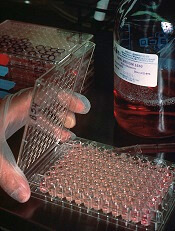
Credit: Linda Bartlett
Preclinical research suggests the B-cell activating receptor (BAFF-R) may be a promising therapeutic target for treatment-resistant leukemia.
A monoclonal antibody (mAb) that targets BAFF-R overcame resistance to nilotinib and enhanced the efficacy of both nilotinib and vincristine in vitro.
The mAb, called B-1239, also demonstrated antileukemic effects in mouse models, when given alone. But it did not appear to improve upon the effects of nilotinib when given in combination.
Nora Heisterkamp, PhD, of Children’s Hospital Los Angeles in California, and her colleagues reported these findings in Molecular Cancer Therapeutics.
In a previous study, the researchers had shown that BAFF-R is expressed on pre-B ALL cells but not on their normal counterparts.
“We’ve now demonstrated that BAFF-R is a strong potential therapeutic target for treating chemotherapy-resistant leukemia cells, without damaging healthy cells,” Dr Heisterkamp said.
She and her colleagues began this research by generating pre-B ALL cells from the bone marrow of wild-type mice and BAFF-R-null mice with a retroviral vector carrying the BCR/ABL oncogene. They found that wild-type pre-B-ALL cells expressed high levels of BAFF-R.
The team then treated both wild-type and BAFF-R-deficient leukemic cells with nilotinib. The wild-type cells developed resistance to nilotinib in 9 to 10 days, but the BAFF-R-deficient cells were eradicated by treatment.
The researchers next tested the effects of B-1239, a human codon-optimized anti-BAFF-R mAb. B-1239 bound to BAFF-R on both Ph-positive and Ph-negative ALL cells in vitro, and the mAb inhibited BAFF-R in a dose-dependent manner.
In pre-B-ALL cells, B-1239 alone had little effect on cell viability or proliferation. However, when combined with vincristine or nilotinib, B-1239 reduced cell count and viability more than either agent alone.
The researchers also found that B-1239 stimulated natural killer cell-mediated cytotoxicity in patient-derived ALL cells. And the mAb stimulated phagocytosis by macrophages.
Finally, Dr Heisterkamp and her colleagues tested B-1239 in mice transplanted with TXL2 cells. Mice received human IgG, B-1239 alone, nilotinib alone, or nilotinib and B-1239.
At 12 days after the last treatment, leukemia cell numbers in the circulation of control mice and B-1239-treated mice were comparable.
However, B-1239-treated mice showed significant inhibition of ALL cell growth in the bone marrow and spleen, when compared to control mice. mAb-treated mice also had significantly lower spleen weights than controls.
Nilotinib alone also significantly reduced the ALL cell burden in the peripheral blood, spleen, and bone marrow, when compared to controls. But there was no significant difference in these measures between mice that received nilotinib alone or nilotinib plus B-1239.
Nevertheless, Dr Heisterkamp and her colleagues said they will continue to evaluate the use of B-1239 for the treatment of ALL.

